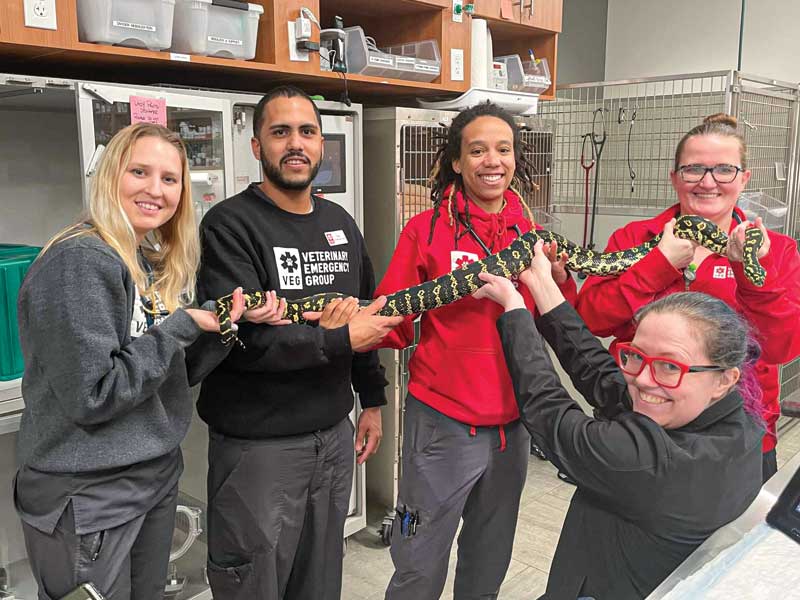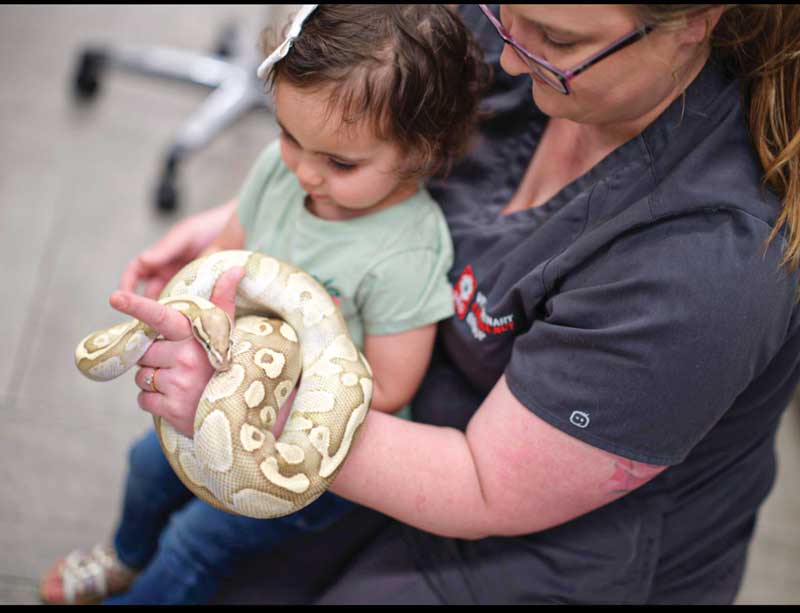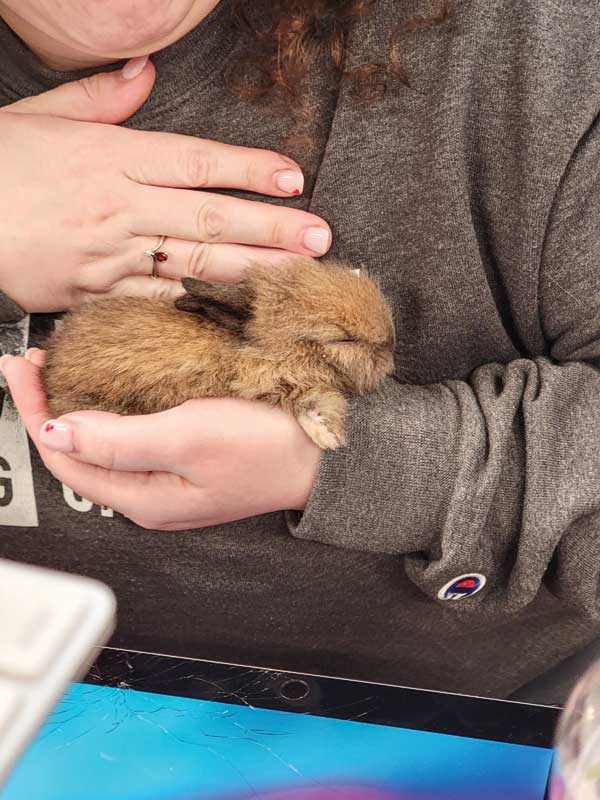
For veterinary professionals who typically work with only dogs and cats, the thought of seeing an exotic pet in an emergency situation may be intimidating. Many concerns have been brought up by veterinary professionals for why exotic pet emergencies are not as welcomed in their practices as canines and felines, including:
- Not knowing how to handle or restrain the species
- Not having the supplies, medications, equipment, etc., needed
- Not knowing what drug dosages are safe and effective
- Lacking references/resources for appropriate care
- Not knowing normal vital signs
- Lacking team members who are comfortable working with the species
These are all valid concerns and may be good reasons not to see an exotic pet emergency, but there are ways to quelch these and prepare for unexpected exotic pets.
According to a 2021-2022 survey on pet owners, 6.2 million households own small animals (up from 5 million in 2011-2012), 9.9 million households own birds (up from 5.7 million in 2011-2012), and 5.7 million households own reptiles (up from 4.6 million in 2011-2012).1 This comes to a grand total of 21.8 million households that have at least one of these exotic pet species, suggesting exotic pets are becoming more commonplace in homes.
Further, many of these 21.8 million households also own cats and/or dogs and may already be clients of veterinary professionals who are leery of seeing exotic pets. Being comfortable and capable of seeing an exotic pet emergency, especially if it is brought in by a current client, is not only good customer service, but is likely an expectation of the client.
There are four key steps a veterinary team can take to prepare to see an exotic pet emergency:
- Determining what kind of exotic pets will be seen
- Gathering necessary supplies
- Obtaining reference sheets with species vital signs
- Knowing what reliable resources are available
What kinds of exotic pets will be seen?
Before anything else, the kinds of exotic pets the doctors, veterinary technicians/nurses, and assistants are willing and able to work with should be identified.
For quick reference, provide customer-facing team members with a list of the species each doctor would be able see (or not see, if that list is shorter) in case a client calls in with a request. This will empower the front desk team to make quick decisions on whether a doctor currently working is able to treat the kind of exotic pet.
Next, the comfort level of the rest of the veterinary team should be considered to determine who can provide basic handling and restraint of exotic pets. The different kinds of exotic pets the doctors will see should be noted down, then the names of the team members able to handle them should be added.
For example, if a hospital has three team members comfortable handling birds, list their names under the headline “Birds.” This will act as a quick reference guide for the doctors to see which technician/nurse or assistant they can ask for help.
If team members express a lack of knowledge, discomfort, or uneasiness in handling and restraint of a specific species, this should be a focus for continuing education either internally or externally. Numerous online and in-person continuing education opportunities exist from various companies and conferences, but if there is at least one team member who already knows how to safely handle and restrain the specific species of concern, a team meeting can quickly provide training to those who need it.

What supplies are needed?
Before an exotic pet emergency comes through the hospital doors, veterinary teams need to be prepared to restrain, handle, medicate, examine, and weigh the species they plan to care for. This means a list of supplies should be available for each major category of exotic pets (i.e. birds, pocket pets, and reptiles).
Some hospitals find having an “Exotics Box” for each category of pets is beneficial in keeping items in a centralized location, while others keep all the necessary supplies in a specific cabinet, drawer, or exam room. The list should be kept with the actual supplies so items can be easily restocked as needed, too. Many veterinary teams may be surprised to find that they already have the majority of what they need to treat exotic pets so necessary expenses to prepare for emergencies are minimal.
What are normal vital signs for exotic pet species?
Normal dog and cat vital signs are usually memorized by small animal veterinary team members, but those of exotics are not as memorable if the specific species are not seen on a regular basis. As with dog and cat vital signs, if team members do not know what normal vitals are, they will not be able to recognize abnormal vitals when they see them. Thankfully, a simple reference chart for pocket pets and birds can help during emergencies.
| POCKET PET | HR | RR | BODY TEMP ºF |
| Chinchilla | 150-250 | 40-80 | 98.5-100.4 |
| Degu | 100.9 | ||
| Fennec fox | 340-600 | 25-45 | |
| Ferret | 118 | 23 | 100.8 |
| Gerbil | 260-300 | 90 | 102.2 |
| Guinea pig | 270-290 | 100.4 | |
| Hamster | 350 | 80 | 99.32 |
| Hedgehog, African Pygmy | 180-280 | 25-50 | 95.7-98.6 |
| Mouse | 500-600 | 180 | 99.32 |
| Rabbit, European | 220 | 55 | 100.4 |
| Rat | 350 | 80 | 100.4 |
| Sugar glider | 200-300 | 16-40 | 96.5-97.9 |
| BIRD | HR | RR | BODY TEMP ºF |
| Canary | 274 | 60-80 | 108 |
| Cockatiel | 206 | 40-50 | 107.1 |
| Lovebird | 206-274 | 50-60 | 107.1 |
| Amazon Parrot | 340-600 | 15-45 | 107.1 |
| Macaw | 275-389 | 20-25 | 107.7 |
| Grey Parrot | 340-600 | 25-45 | 105.8 |
| Eclectus | 340-600 | 25-45 | 105.8 |
What exotic pet resources are available?
The final step in preparing to see exotic pet emergencies is to know what resources are available to the veterinary team to aid them in the treatment and care of a patient.
- Publication. The Exotic Animal Formulary by James Carpenter is a popular reference recommended to be kept in the hospital’s “Exotics Box” or easily accessible elsewhere. This drug formulary not only contains medication dosages and indications for the vast majority of species kept as pets, but it also houses information on diets, physiologic and biochemistry reference ranges, and more.
- Websites. Lafeber.com/vet is an online resource offering information, articles, and even client handouts for common exotic pets. OxbowAnimalHealth.com/vet-connect and Emeraid.com/vet/veterinarians focus primarily on exotic pet nutrition, something that is especially important in exotic pet emergencies since most species have a fast metabolic rate and, therefore, need intensive nutritional support to survive.
To quickly educate themselves on a species of exotic pet that is being seen, veterinary professionals can visit TheSprucePets.com for free articles written and/or reviewed by licensed veterinarians and/or licensed veterinary technicians. Since many exotic pet health concerns are due to poor husbandry, knowing what an exotic pet should receive versus what the pet owner actually provides can aid in making a quick diagnosis.
Additionally, the Veterinary Information Network (VIN) and the Veterinary Support Personnel Network (VSPN) offer message boards and continuing education to connect and learn from other veterinary professionals online.
Finally, if a veterinary team cannot provide the necessary level of care or continued care to a specific species of exotic pet, a list of other hospitals should be on hand to refer clients to. The American Board of Veterinary Practitioners (ABVP) website is another platform to search for an exotic pet specialist, but knowing what other hospitals in the area are able and willing to see exotic pets, even if they are not specialists, should also be known.
Adrienne Kruzer, BBA, RVT, LVT, is a credentialed veterinary technician in Ohio, NC, and South Carolina. Kruzer writes for various publications, lectures at veterinary conferences and colleges across the U.S., and currently works for Veterinary Emergency Group as the veterinary nursing program manager. She also volunteers her time as a district representative and board member for the South Carolina Association of Veterinary Technicians and actively represents her profession on social media.
References
- American Pet Products Association’s 2021-2022 National Pet Owners Survey
- American Pet Products Association’s 2011-2012 National Pet Owners Survey
- “Traditions and Ceremonies | Girl Scouts.” Accessed June 13, 2023. https://www.girlscouts.org/en/members/for-volunteers/traditions-and-ceremonies.html#:~:text=Motto%3A%20The%20Girl%20Scout%20motto,The%20same%20holds%20true%20today.
- VTS (Anesthesia/Analgesia), Katrina Lafferty, RLAT. “Monitoring Vital Signs in Exotic Animal Species.” LafeberVet (blog), May 22, 2018. https://lafeber.com/vet/monitoring-vital-signs-in-exotic-animal-species

